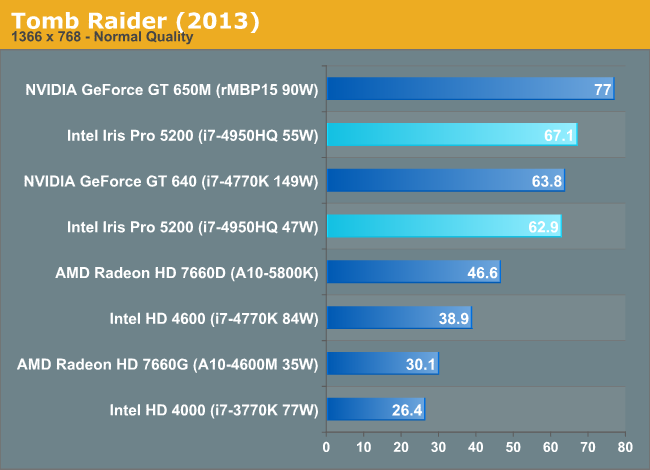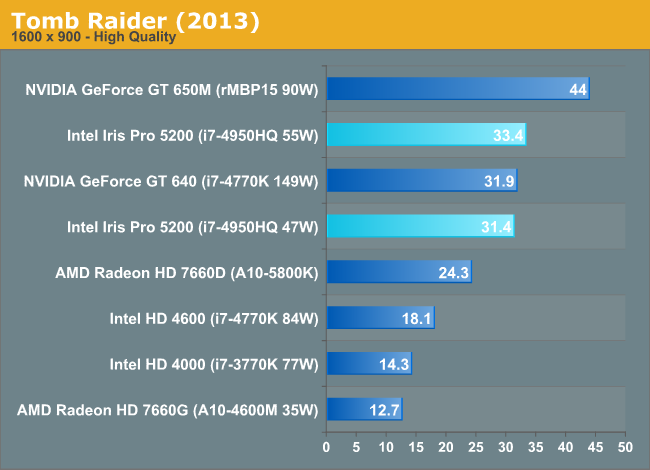Intel Iris Pro 5200 Graphics Review: Core i7-4950HQ Tested
by Anand Lal Shimpi on June 1, 2013 10:01 AM ESTTomb Raider (2013)
The simply titled Tomb Raider is the latest entry in the Tomb Raider franchise, making a clean break from past titles in plot, gameplay, and technology. Tomb Raider games have traditionally been technical marvels and the 2013 iteration is no different. iGPUs aren’t going to have quite enough power to use its marquee feature – DirectCompute accelerated hair physics (TressFX) – however even without it the game still looks quite good at its lower settings, while providing a challenge for our iGPUs.

Once again, at 1366 x 768 the gap between 650M and Iris Pro 5200 is at its smallest. Here NVIDIA holds a 15% advantage over the 55W Iris Pro.

Increase the resolution and image quality and the gap widens considerably. Again the problem here appears to be AA impacting Iris Pro much more than the 650M.










177 Comments
View All Comments
beginner99 - Saturday, June 1, 2013 - link
Impressive...if you ignore the pricing.tipoo - Sunday, June 2, 2013 - link
?velatra - Saturday, June 1, 2013 - link
On page 4 of the article there 's a word "presantive" which should probably be "representative."jabber - Saturday, June 1, 2013 - link
May I ask why The Sims is never featured in your reviews on such GPU setups?Why? Well in my line of business, fixing and servicing lots of laptops with the integrated chips the one game group that crops up over and over again is The Sims!
Never had a laptop in from the real world that had any of the games you benchmarked here. But lots of them get The Sims played on them.
JDG1980 - Saturday, June 1, 2013 - link
Agreed. The benchmark list is curiously disconnected from what these kind of systems are actually used to do in the real world. Seldom does anyone use a laptop of any kind to play "Triple-A" hardcore games. Usually it's stuff like The Sims and WoW. I think those should be included as benchmarks for integrated graphics, laptop chipsets, and low-end HTPC-focused graphics cards.tipoo - Saturday, June 1, 2013 - link
Because the Sims is much easier to run than most of these. Just because people tried running it on GMA graphics and wondered why it didn't work doesn't mean it's a demanding workload.jabber - Saturday, June 1, 2013 - link
Yes but the point is the games tested are pretty much pointless. How many here would bother to play them on such equipped laptops?Pretty much none.
But plenty 'normal' folks who would buy such equipment will play plenty of lesser games. In my job looking after 'normal' folks thats quite important when parents ask me about buying a laptop for their kid that wants to play a few games on it.
The world and sites such as Anandtech shouldnt just revolve around the whims of 'gamer dudes' especially as it appears the IT world is generally moving away from gamers.
It's a general computing world in future, rather than a enthusiast computing world like it was 10 years ago. I think some folks need to re-align their expectations going forward.
tipoo - Sunday, June 2, 2013 - link
I mean, if it can run something like Infinite or even Crysis 3 fairly well, you can assume it would run the Sims well.Quizzical - Saturday, June 1, 2013 - link
It would help immensely if you would say what you were comparing it to. As you are surely aware, a system that includes an A10-5800K but cripples it by leaving a memory channel vacant and running the other at 1333 MHz won't perform at all similarly to a properly built system with the same A10-5800K with two 4 GB modules of 1866 MHz DDR3 in properly matched channels.That should be an easy fix by adding a few sentences to page 5, but without it, the numbers don't mean much, as you're basically considering Intel graphics in isolation without a meaningful AMD comparison.
Quizzical - Saturday, June 1, 2013 - link
Ah, it looks like the memory clock speeds have been added. Thanks for that.